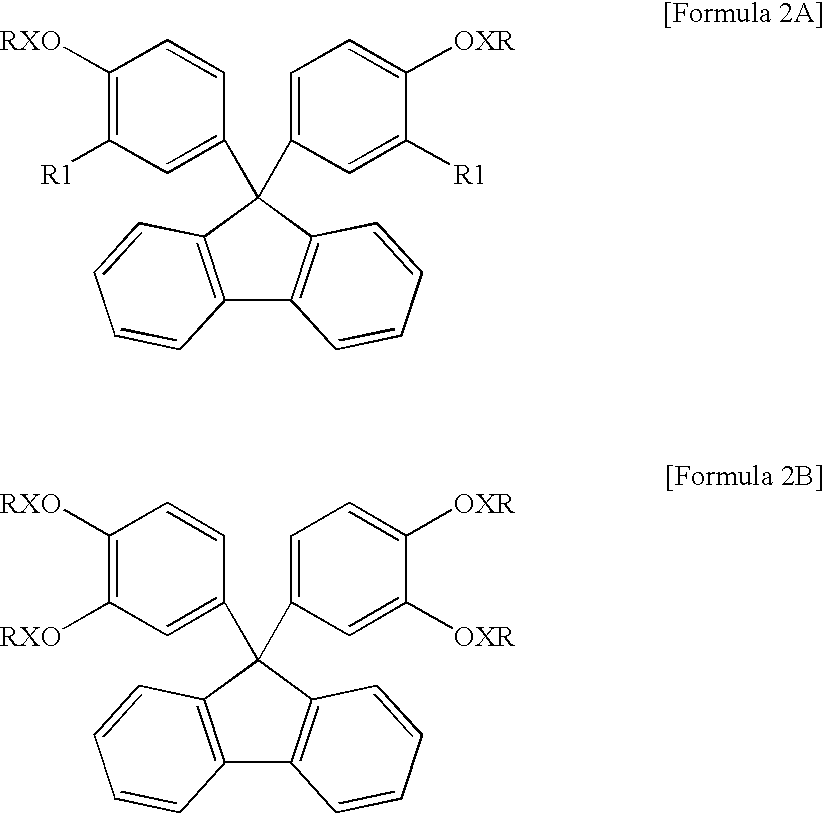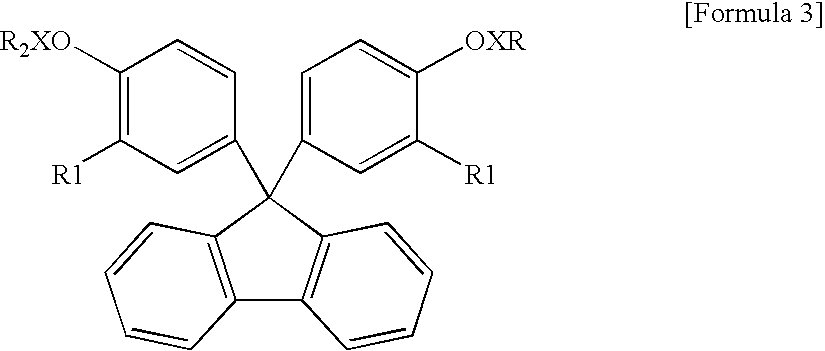Encapsulating resin composition and light-emitting device
a technology of encapsulating resin and composition, which is applied in the direction of synthetic resin layered products, tyre parts, disinfection, etc., can solve the problems of lack of physical flexibility of cured products, and achieve the effects of physical flexibility and thermal stress relaxation properties, excellent transparency, and low shore hardness
- Summary
- Abstract
- Description
- Claims
- Application Information
AI Technical Summary
Benefits of technology
Problems solved by technology
Method used
Image
Examples
example 1
(1) Synthesis of the Nonfunctional Fluorene Compound
[0068]87.7 g (0.2 moles) of 9,9-bis(4-(2-hydroxyethoxy)phenyl)fluorene (product of JFE Chemical Corporation, product name: BPEF) and 32.6 g (0.44 moles) of propionic acid were dissolved in 250 mL of toluene. The mixture was charged into a 1 L glass reaction vessel equipped with a cooling tube, an agitator, and a thermometer. While nitrogen gas was fed into the reaction vessel, the mixture was externally heated to 100° C. using an oil bath. 0.8 mL of concentrated sulfuric acid was added to the mixture to initiate the esterification reaction. Water produced by the reaction was continuously discharged to outside the system through its azeotrope with toluene. After 5 hours, the substantial completion of the reaction was confirmed through FT-IR. Next, the temperature was increased to 115° C., and the reaction was continued for another one hour. At this point, no further discharge of water produced by the reaction was observed, and only ...
example 2
[0071]The same procedure as in Example 1 was repeated except that, as the high-refractive index (meth)acrylic-based monofunctional monomer, 2-(2-acryloyloxyethoxy)biphenyl (product of TOAGOSEI CO., LTD., product name TO-1463, refractive index: 1.5785) was used in place of paracumylphenoxy acrylate, to thereby prepare an encapsulating resin composition and a sheet of the cured product thereof.
example 3
[0072]The same procedure as in Example 1 was repeated except that, as the high-refractive index (meth)acrylic-based monofunctional monomer, 30 g of 2-(2-acryloyloxyethoxy)biphenyl (product of TOAGOSEI CO., LTD., product name TO-1463, refractive index: 1.5785) was used in place of paracumylphenoxy acrylate and that 10 g of 2,2-bis(4-(acryloxydiethoxy)phenyl)propane (product of Shin-nakamura Chemical Corporation, product name: NK ester A-BPE-4, refractive index: 1.5365) serving as the diluting monomer was used, to thereby prepare an encapsulating resin composition and a sheet of the cured product thereof.
PUM
| Property | Measurement | Unit |
|---|---|---|
| refractive index | aaaaa | aaaaa |
| refractive index | aaaaa | aaaaa |
| refractive index | aaaaa | aaaaa |
Abstract
Description
Claims
Application Information
 Login to View More
Login to View More - R&D
- Intellectual Property
- Life Sciences
- Materials
- Tech Scout
- Unparalleled Data Quality
- Higher Quality Content
- 60% Fewer Hallucinations
Browse by: Latest US Patents, China's latest patents, Technical Efficacy Thesaurus, Application Domain, Technology Topic, Popular Technical Reports.
© 2025 PatSnap. All rights reserved.Legal|Privacy policy|Modern Slavery Act Transparency Statement|Sitemap|About US| Contact US: help@patsnap.com



